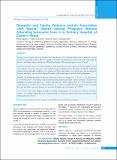Please use this identifier to cite or link to this item:
https://hdl.handle.net/20.500.14356/1069| Title: | Domestic and Family Violence and its Association with Mental Health Among Pregnant Women Attending Antenatal Care in a Tertiary Hospital of Eastern Nepal |
| Authors: | Sapkota, Diksha Anderson, Debra Saito, Amornrat Baird, Kathleen |
| Citation: | SapkotaD., AndersonD., SaitoA., & BairdK. (2021). Domestic and Family Violence and its Association with Mental Health Among Pregnant Women Attending Antenatal Care in a Tertiary Hospital of Eastern Nepal. Journal of Nepal Health Research Council, 19(1), 115-121. https://doi.org/10.33314/jnhrc.v19i1.2508 |
| Issue Date: | 2021 |
| Publisher: | Nepal Health Research Council |
| Article Type: | Original Article |
| Keywords: | Association domestic violence mental health observational study prevalence |
| Series/Report no.: | Jan-March, 2021;2508 |
| Abstract: | Abstract Background: Pregnancy has been identified as a vulnerable period for both the initiation and escalation in severity of domestic and family violence. There is a significant dearth of scholarly literature documenting the relationship of domestic and family violence with the mental health and quality of life among pregnant women of Nepal. Methods: Baseline data of 140 women enrolled in a trial of a psychosocial intervention for abused pregnant women were analysed. Face-to-face interviews were conducted using standardised scales. Prevalence of domestic and family violence and mental health conditions were estimated and inferential statistics were used to assess the association of domestic and family violence with mental health, quality of life, social support, and use of safety behaviours. Results: The lifetime prevalence of domestic and family violence was found to be 27.7% (n = 173), followed by 17.1% of women (n = 107) fearing someone in their family. Domestic and family violence in the last 12 months was significantly associated with anxiety (p = 0.001), depression (p = 0.005), quality of life (p < 0.05), and perceived social support (p = 0.001). Use of safety behaviours (p = 0.037) was significantly low among women reporting domestic and family violence in the past year as well as during the current pregnancy (p = 0.017). Conclusions: There exists a high psychological morbidity among pregnant women exposed to domestic and family violence. The findings support the need of implementing a screening and support intervention for abused women seeking antenatal services. Keywords: Association; domestic violence; mental health; observational study; prevalence |
| Description: | Original Article |
| URI: | http://103.69.126.140:8080/handle/20.500.14356/1069 |
| ISSN: | Print ISSN: 1727-5482; Online ISSN: 1999-6217 |
| Appears in Collections: | Vol. 19 No. 1 (2021): Vol. 19 No. 1 Issue 50 Jan-Mar 2021 |
Files in This Item:
| File | Description | Size | Format | |
|---|---|---|---|---|
| 2508-Manuscript-21563-1-10-20210425.pdf | Fulltext Download | 361.91 kB | Adobe PDF |  View/Open |
Items in DSpace are protected by copyright, with all rights reserved, unless otherwise indicated.
